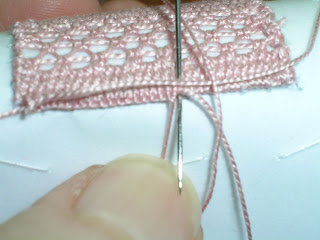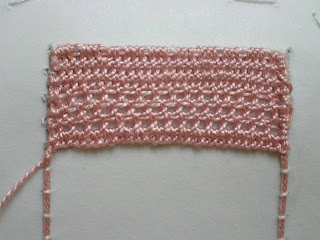In early April I will go to England, to Newbury, near London, to follow a course of Point de Gaze, taught by Catherine Barley.
I realize that this is madness: I can chat with other students just because I will understand their language, and I am afraid not to be at a level appropriate to do well this lace so fine.
my conviction was strengthened when I saw the size of the work we have done in three days: 7 cm X 4 (more festoons of finishing). Inside is a rose, with leaves and various decorations. I wonder if I can at least see the wires.
For now I have to outline, in order to have the base ready on arrival. I try, pubblicherò gli aggiornamenti sulla progressione del lavoro
Ma cos'è questo Point de Gaze? Per avere un'idea della versione moderna, vi rimando QUI , al post su Catherine Barley, appunto.
Questo tipo di merleto è tipico delle Fiandre, nasce a Bruxelles, poi si espande nelle città vicine, in particolare a Gand (Gent). Si inizia a produrre dopo la Rivoluzione Francese, sull'esempio dei merletti di Alençon e Argentan, dapprima con fondo a barrette (brides), poi su fondo tutto lavorato con filo molto sottile, tipo tulle (Gaze).
Ecco nato il point de Gaze, che poi evolve in modo autonomo assumendo le caratteristiche che lo contraddistinguono.
I disegni sono floreali, molte rose, peonie, altri fiori, solo in parte stilizzati, spesso accompagnati da farfalle, e ramages vari, il tutto legato da una retina molto sottile, eseguita in giri di andata e ritorno in punto festone ritorto.
 |
| Quello che io chiamo punto festone ritorto |
Molto spesso le ali delle farfalle o alcuni petali dei fiori sono in rilievo, lavorati a parte ed applicati al merletto in un secondo tempo; questi elementi in rilievo are peculiar to the Point de Gaze.
Other specifications are:
- inside the flowers, there are parts that pierced, performed with the same technique as the underlying network, but with larger wire
- especially within the flower designs (circles, roses , solid lines) which are partly derived from the "modes" of French lace
- the outline, which is called "Cordonnet" is made with a much thicker wire, which is only partially covered with buttonhole stitch, with points spaced , which only serve to keep it in place.
In the ensuing period, per velocizzare il lavoro, solo gli elementi decorative venivano eseguiti ad ago, erano applicati su un fondo fatto a fuselli (più rapido) o addirittura su un tulle meccanico.
Ecco un esempio di decorazione eseguita per un ventaglio prima dell'applicazione sul fondo:
Mi pare, tra l'altro, che il contorno esterno sia eseguito a tombolo, se vedo bene.

















































